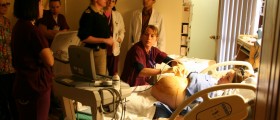
The double screen test is a blood test carried out during the first or second trimester of pregnancy. Its main point is to reveal Down Syndrome, and it's offered to anyone who is perceived to be at higher risk of having a baby with Down's. This is a test that measures hCG levels in your blood, as well as pregnancy associated plasma protein. High levels of both of these signal an increased likelihood that the baby you are carrying has Down Syndrome. It is said that around 60 percent of all cases of Down are revealed in this way.
The triple screen test is carried out in the second trimester of pregnancy and looks at three markers hCG, oestriol and alpha fetoprotein (AFP). The positive aspects of blood tests to discover fetal anomalies is that there are no risks involved for your baby, unlike more invasive tests like an amniocentesis. This test is associated with am increase in the chance of miscarriage or preterm labor, and is more invasive. (See amniocentesis what are the risks?)
Double and triple screening tests do carry the risk that you will get a false positive that you are found to be at an increased chance of having a baby with Down Syndrome, while your baby is in fact totally healthy. That is why, if you decide to opt for the screening tests, they should be carried out in combination with diagnostic ultrasounds and the nuchal fold test, to increase accuracy rates.

















Your thoughts on this
Loading...